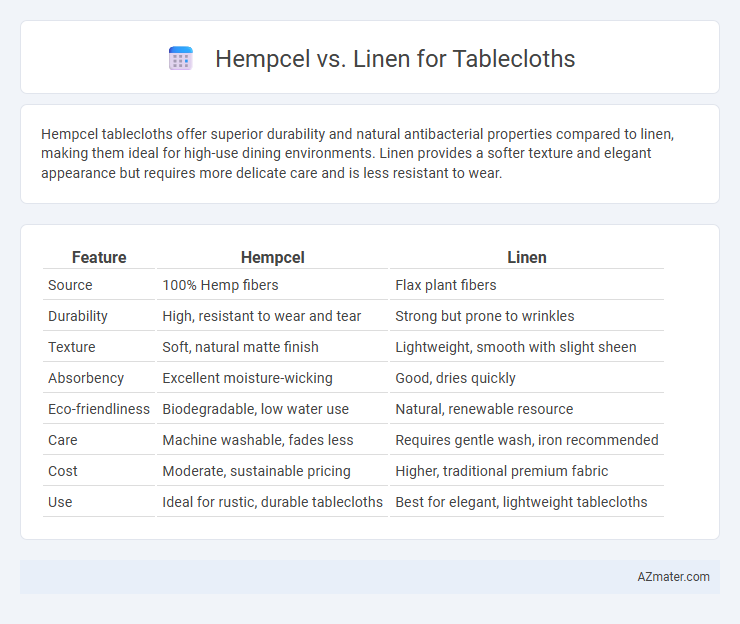Hempcel tablecloths offer superior durability and natural antibacterial properties compared to linen, making them ideal for high-use dining environments. Linen provides a softer texture and elegant appearance but requires more delicate care and is less resistant to wear.
Table of Comparison
| Feature | Hempcel | Linen |
|---|---|---|
| Source | 100% Hemp fibers | Flax plant fibers |
| Durability | High, resistant to wear and tear | Strong but prone to wrinkles |
| Texture | Soft, natural matte finish | Lightweight, smooth with slight sheen |
| Absorbency | Excellent moisture-wicking | Good, dries quickly |
| Eco-friendliness | Biodegradable, low water use | Natural, renewable resource |
| Care | Machine washable, fades less | Requires gentle wash, iron recommended |
| Cost | Moderate, sustainable pricing | Higher, traditional premium fabric |
| Use | Ideal for rustic, durable tablecloths | Best for elegant, lightweight tablecloths |
Introduction: Hempcel vs Linen Tablecloths
Hempcel tablecloths offer exceptional durability and natural resistance to wear, making them ideal for long-lasting use. Linen tablecloths provide a luxurious texture and breathability, favored for their elegant appearance and ability to soften with each wash. Both fabrics are eco-friendly choices, but Hempcel's higher tensile strength and moisture-wicking properties make it particularly suited for heavy-duty or everyday dining settings.
Material Origins: Hempcel and Linen Explained
Hempcel is derived from hemp fibers combined with cellulose, creating a sustainable fabric that blends durability with eco-friendliness. Linen originates from the flax plant, known for its natural strength and breathability, making it a traditional choice for tablecloths. Both materials emphasize natural fiber origins but differ in plant source and texture, influencing their environmental impact and aesthetic appeal.
Environmental Impact Comparison
Hempcel tablecloths offer a lower environmental footprint compared to linen due to hemp's faster growth rate and reduced need for pesticides and water. Linen, derived from flax, requires less water than cotton but involves intensive retting processes that can impact local ecosystems. Choosing Hempcel supports sustainable agriculture practices, with hemp's carbon sequestration properties contributing to soil health and reduced greenhouse gas emissions.
Texture and Feel: Sensory Differences
Hempcel tablecloths offer a coarse, natural texture with a slightly rough feel, providing a rustic and organic aesthetic that softens with use and washing. Linen tablecloths present a smoother, crisp texture that feels cool and luxurious against the skin, known for maintaining durability while becoming softer over time. Sensory differences between Hempcel and linen make the former ideal for a casual, earthy ambiance, whereas linen suits formal settings requiring elegance and refined tactile experience.
Durability and Longevity
Hempcel tablecloths offer superior durability due to their high tensile strength and natural resistance to wear, outperforming linen in maintaining shape and texture over time. Linen, while durable and breathable, tends to develop thinning areas and may weaken faster with frequent washing compared to Hempcel's robust fibers. For long-term tablecloth use, Hempcel provides enhanced longevity, resisting fraying and fading more effectively than traditional linen fabrics.
Aesthetic Appeal in Table Settings
Hempcel tablecloths provide a rustic, natural texture with a coarse yet soft finish that enhances earthy and bohemian table settings. Linen offers a classic, smooth elegance with a subtle sheen that elevates formal and minimalist dining environments. Both materials age gracefully, developing unique character; Hempcel's robust fibers deepen in tone, while Linen softens and becomes more lustrous over time.
Maintenance and Care Requirements
Hempcel tablecloths require minimal maintenance, with natural resistance to stains and mildew, making them ideal for frequent use and easy cleaning through machine washing in cold water. Linen tablecloths need more delicate care, often requiring gentle hand washing or dry cleaning to preserve their fibers and avoid shrinkage or damage. Both materials benefit from air drying and ironing on low heat to maintain their appearance, but Hempcel offers greater durability and ease in everyday handling.
Cost Analysis: Hempcel vs Linen
Hempcel tablecloths generally offer a more affordable option compared to linen, with prices averaging 20-30% lower due to the lower cultivation and processing costs of hemp fibers. Linen, derived from flax plants, tends to have a higher market value because of its longer production cycle and labor-intensive manufacturing process. Budget-conscious consumers often find Hempcel to provide comparable durability and aesthetic quality at a reduced cost, making it a cost-effective alternative to traditional linen tablecloths.
Stain Resistance and Performance
Hempcel tablecloths exhibit superior stain resistance due to their natural antimicrobial properties and durable fiber structure, making them highly effective against food and wine spills. Linen, while elegant and breathable, tends to absorb stains more readily and may require more frequent laundering and stain treatment to maintain its appearance. Both materials offer strong performance, but Hempcel provides enhanced durability and easier maintenance in high-traffic dining settings.
Final Recommendation: Choosing the Best Tablecloth
Hempcel tablecloths offer superior durability and eco-friendly properties, making them ideal for long-term use and sustainability-conscious consumers. Linen tablecloths provide a luxurious texture and elegant drape, perfect for formal dining settings requiring a classic aesthetic. For practical everyday use prioritizing strength and environmental impact, Hempcel is the best choice, while Linen suits occasions demanding refined appearance and traditional charm.

Infographic: Hempcel vs Linen for Tablecloth
 azmater.com
azmater.com